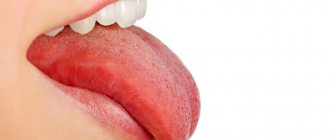What is thrush
Thrush (or candidiasis) is a type of stomatitis (inflammation of the mucous membrane in the mouth) caused by a yeast-like fungus of the genus Candida. It is this fungus that causes the disease, usually transmitted through contact with an infected person.
The fungus is not a “guest” in the body: like other microorganisms, it always lives on the mucous membranes of the intestines, genitals, and mouth, but in small quantities. However, such a normal state is possible only with a “friendly” balance of “good” and “harmful” bacteria representing the microflora of the human body. This balance of equilibrium can be disrupted upon contact with a patient with thrush: in this case, a fungal infection from the outside enters the body of a healthy person and begins to multiply quickly there, disrupting the natural microflora.
This is possible when the immune system is weakened, when the number of “good” bacteria sharply decreases, and they are unable to fight the growing number of “harmful aliens.”
The occurrence of thrush in the mouth in children over the age of one year is explained by the fact that when they come into contact with each other, they pass toys and objects that they take in turn in their mouths, and among them there is often at least one child infected with candidiasis. And since the child’s immunity is still in the development stage, its internal protection is weakened, so infection occurs very quickly.
Prevention of thrush
Considering the reasons for the development of thrush in children, it is worth noting ways of prevention .
The most important thing: during pregnancy, a woman must carefully monitor her health, follow personal hygiene and doctor’s recommendations, including those related to nutrition.
If you have thrush, it is advisable to reduce your consumption of sweets, flour, and fatty foods, increasing the proportion of vegetables, fruits, and whole grain bread in your diet.
Early breastfeeding after childbirth promotes the formation of normal intestinal microflora in the child, which prevents the proliferation of opportunistic microorganisms. When artificial feeding and using pacifiers and nipple shields, it is important to sterilize these items in a timely manner. For a newborn, it is not enough to pour boiling water over a bottle or pacifier: up to six months, boiling or using a sterilizer is required. In the second half of the year, the child begins to lead a more active lifestyle, so-called domestic infection occurs, while the baby’s immunity increases, and the need for sterilization disappears.
Symptoms of thrush in the mouth of a baby
What does thrush look like in a baby? When a fungal infection enters the child’s oral mucosa, its proliferation leads to inflammation in the mouth area. Therefore, quite quickly you will be able to notice small crumbs of white “cereal”, reminiscent of cottage cheese, on the child’s cheeks, palate, gums and tongue. An inexperienced mother may well assume that this is the remains of milk or formula after regurgitation. But checking whether this is so is quite simple: take dry sterile gauze or a bandage and very carefully try to remove the white coating. If these are really leftover food, they will be easily removed; if it is thrush, it will be more difficult to erase the curdled coating. And after removing it, you will notice inflamed redness in the oral cavity. If your baby has thrush, his appetite and sleep will most likely worsen, and he will become restless and moody.
Causes of stomatitis in infants
The main cause of stomatitis in infants is weakness of local and general immunity. A newborn baby can be called “sterile”: neither bacteria nor viruses are unfamiliar to its immune system. Therefore, even minor damage to the mucosa can become an entry point for infection. And the low activity of protective mechanisms leads to the active reproduction of viruses, microbes and the appearance of inflammation of oral tissues.
The following can also contribute to the development of stomatitis in a child:
- Intrauterine infections
- Birth injuries
- Infecting a child with infectious diseases during childbirth
- Lack of vitamins and microelements
- Taking antibiotics, hormones, sulfa drugs
- Congenital malformations5
Children in the first year of life often develop traumatic stomatitis. Its cause is damage to the gums and tongue from the sharp edges of toys or trauma to the mucous membrane that occurs due to a strong “hobby” with teethers. Infection immediately penetrates into the resulting wounds, causing inflammation. Therefore, it is very important to ensure that your baby’s toys are safe and clean: rattles and teethers should be washed from time to time in hot water and baby soap6.
Causes of oral thrush in newborns
How can Candida fungi get into a baby’s body?
- infection can occur during the mother’s pregnancy if she suffers from genital candidiasis on the eve of childbirth: during the birth process, a fungal infection enters the placenta and amniotic fluid, and then into the newborn’s body;
- a baby can also become infected from a nursing mother if her nipples are affected by a fungal infection;
- when a child is bottle-fed or sucks on a pacifier, it, as well as bottles and nipples, must be treated in a sterilizer or boiled water before giving it to the newborn; unsterile nipples can cause bacteria to enter the oral cavity;
- the fungus can live not only on the mucous membrane, but also on the skin of the hands, from where it can easily migrate to the skin of the child if he is cared for by a person affected by thrush;
- The fungus can also be found in pet hair, dust, raw vegetables, meat or milk, so after contact with all these “transmitters” of bacteria, you must wash your hands thoroughly before touching the newborn;
- treatment with antibiotics can also disrupt the natural balance of the body's microflora; as a result of antibiotic therapy, candidiasis occurs in mother and baby who did not take medications containing “beneficial” bacteria along with antibiotics;
- candidiasis can occur if the mother has not learned how to properly attach the baby to the breast during feeding; the child may swallow too much air when sucking and, as a result, often burp; under such circumstances, most of the dairy food can remain in the child’s mouth, giving rise to fermentation processes and promoting the proliferation of fungi.
- thrush often develops in premature babies because their immune defenses are still too weak;
- candidiasis during artificial feeding can affect the baby due to the fact that he does not receive substances from mother’s milk that suppress the growth of fungal microflora;
- if the mucous membranes in the child’s mouth often dry out due to too dry air in the room or thirst, then such situations can contribute to the development of thrush;
- if the child’s immunity is reduced due to illness, poor sleep, lack of vitamins, then this can also cause fungi to multiply;
- candidiasis can also have a chronic form: in this case, it is often caused by serious illnesses in the child - diabetes, leukemia, HIV.
Thrush in infants
Karanashev Artur Adamovich
4.9
Urologist, Surgeon, Andrologist 34 years of experience
Consultation from 2100 rub.
Calling a doctor to your home
Provides treatment for andrological and urological diseases: medical support for married couples in pregnancy planning, treatment of male infertility, preparation for in vitro fertilization; treatment of prostatitis (abacterial, bacterial, congestive and other forms of the disease), including complex drug treatment, modern physiotherapy techniques, prostate massage; sexually transmitted infections; prostate adenomas; erectile dysfunction, organic and inorganic nature; accelerated, premature, painful ejaculation (ejaculation); acute and chronic inflammatory diseases of the upper, lower urinary tract, scrotal organs (pyelonephritis, cystitis, urethritis, orchitis, epididymitis); hormonal deficiency (androgen deficiency); urolithiasis (diagnosis, prevention, drug and surgical treatment, metaphylaxis of kidney stones, ureters, bladder). Performs all types of endoscopic and radiological examinations in urology: urethroscopy, cystoscopy, excretory urography, urethrography, cystography, retrograde ureteropyelography, diagnosis of vesicoureteral reflux. Operative urology-andrology: plastic surgery for short frenulum of the penis; circumcision - circumcision for phimosis; operations for paraphimosis - dissection of the pinching ring, circumcision; surgical treatment of premature ejaculation - microsurgical denervation of the glans penis; operations according to Winkelmann, Lord, Bergman operation for hydrocele of the testicular membranes; excision of testicular cysts, epididymis; surgical treatment of varicocele on the left (varicose veins of the left testicle) - Ivanissevich operation, Palomo operation, Marmara microsurgical operation; surgical treatment of erectile dysfunction - penile replacement; implantation of testicular prosthesis; Sapozhkov-Reich plastic surgery for oleogranuloma of the penis; Nesbitt operation for Peyronie's disease, a congenital curved penis; anterior, posterior, lower pyelolithotomy, subcapsular pyelolithotomy, nephrolithotomy for large kidney stones. ureterolithotomy for impacted, long-standing ureteral stones; plastic surgery of the ureteropelvic segment with stricture of the ureteropelvic segment, accessory vessel. nephrectomy, nephroureterectomy; nephropexy according to Rivoir-Pytel-Lopatkin for nephroptosis; trocar cystostomy, open cystostomy; transvesical adenomectomy for large adenomas; sling operations for stress urinary incontinence TVT-O. Endoscopic surgical treatment, transurethral endoscopic operations: transurethral resection of bladder formations; urethrotomy for non-extended urethral structures; internal drainage of the urinary tract - installation of a stent in the ureter for urolithiasis, ureteral strictures, renal colic; remote lithotripsy of kidney and ureteral stones; contact cystolithotripsy, lithoextraction - crushing and removal of bladder stones; contact ureterolithotripsy, lithoextraction - crushing and removal of ureteral stones. Performs shock wave therapy.
The doctor was attentive to my problem. Everything was explained and explained clearly
4.5
– Alexey
, July 26, 2022
Dangers of candidiasis for a newborn
Candidiasis can occur in simple and complex forms. And depending on the degree, it contains certain dangers:
- in severe forms of thrush, the fungus can reduce immunity and disrupt the gastrointestinal tract;
- candidiasis in a girl can spread to the vaginal mucosa, creating the risk of a pathology called synergy - fusion of the labia or vaginal mucosa;
- a mild form of thrush, in which it is enough to treat the plaque, usually does not pose any danger;
- with moderate thrush, inflammation forms under the white coating, which begins to bleed during treatment; this form brings additional discomfort and pain to the child; in the absence of proper treatment, the disease can become more severe;
- in severe cases of the disease, the fungal infection spreads throughout the entire oral cavity; in addition to pain and discomfort, the child may have a fever; Difficulties with swallowing can lead to the baby refusing not only food, but also water, which leads to rapid dehydration; this condition is life-threatening for the child, so its treatment is sometimes carried out in a hospital;
- thrush can occur not only in the acute, but also in the chronic stage: in such cases, exacerbation is characterized by the appearance of plaque on the mucous membranes and dry mouth; as a result of the infection spreading to the skin, small ulcers appear in the corners of the child’s mouth, and dense lymph nodes become noticeable to the touch under the jaw; reddish inflammations acquire a brownish tint and become painful, their area increases.
Is research necessary?
Usually, thrush in the mouth of a baby does not require additional research, since it is not difficult for an experienced specialist to diagnose it based on obvious signs. But sometimes, in case of serious lesions, additional studies may be prescribed:
- microscopic: in this case, the doctor will take scrapings from the oral mucosa to examine the yeast-like fungal cells more carefully;
- bacteriological: during such a study, a scraping is also taken and then bacteria are cultured to understand how large the volume of fungal colonies is and how amenable to treatment they are with antifungal drugs; in addition, bacteriological testing helps determine which drug is the most effective in treatment, because some of them may not have an effect in the treatment of thrush;
- serological: this study requires a blood test, in the serum of which antibodies to fungal infection are examined.
How to treat oral thrush in infants
Treatment of oral thrush in an infant is not a complicated process, but it requires the systematic implementation of certain procedures several times a day until the child recovers. If you find a mild degree of thrush in your baby, but at the moment you cannot call a doctor (for example, on a day off), then you can use traditional methods of eliminating thrush. If the degree of damage to the mucous membrane has already reached serious forms, it is better not to risk it and call an ambulance.
Traditional methods for eliminating thrush:
- using a soda solution: prepare a solution (dissolve 1 teaspoon of soda in a glass of warm boiled water), then wrap a sterile bandage around your finger, moisten the winding in the solution and very carefully wipe the areas of fungal infections; Do not rub them under any circumstances, because under the plaque there may be bleeding plaques, through which you risk allowing bacteria to enter the baby’s body; such light rubbing can be done 4 times a day until you have the opportunity to visit a doctor;
- use of honey solution: prepare a solution (dissolve 1 tsp honey in 2 tsp warm boiled water); however, please note that it is unacceptable to use a honey solution if a child is allergic to bee products; if the child tolerates honey well, then treatment with the solution can be carried out similarly to treatment with soda; You can also treat your baby’s pacifiers and toys, which he likes to put in his mouth, with any of these solutions;
- for candidiasis of the nipples, treat them with any of the above solutions;
- You can use other natural antiseptics for rinsing and treating the oral cavity - for example, herbal infusions; you can prepare a decoction of chamomile, green tea, calendula, taking 1 tsp. dry herbs for 1 cup of boiling water; Sage, elecampane, yarrow, burdock, and oak bark also have antiseptic properties, but it is also necessary to understand that any of the herbal preparations can cause an allergic reaction;
- sometimes the contents of aloe vera stems are used as antiseptics, lubricating the affected areas with this juice;
- Among the natural oils that can be used to lubricate the oral cavity, rosehip, flax or peach oils can be used after rinsing or treating plaque.
Self-medication precautions
When choosing methods for self-treatment of oral thrush in a baby, you need to understand that sometimes such procedures may not correct the situation, but on the contrary, harm the child.
For example, improper use of soda solution when treating the oral mucosa can cause additional injuries. Therefore, carefully prepare the soda solution, not exceeding its concentration more than 1-2%, because a stronger concentration leads to a burn to the mucous membrane.
You can complicate the situation with candidiasis by using a honey solution. After all, beekeeping products are one of the most powerful allergens, so when using them you need to be absolutely sure that there is no allergic reaction.
In addition, when using herbal infusions, do not use several herbs at the same time. In this case, if an allergy suddenly arises, you will know which plant caused it.
Similar folk recipes can be used when treating an older child, but it is better not to experiment with the baby’s health. If the situation is urgent and you cannot see a doctor today, it’s better to play it safe and call an ambulance. At your appointment at the clinic, your doctor will prescribe medications to combat the fungal infection. When treated with medications, you can avoid additional risks, and candidiasis will go away faster.
Causes of childhood stomatitis
There are 6 main factors that can provoke the occurrence of stomatitis in the mouth in infants:
- infections;
- mechanical damage;
- physical agents;
- chemical burns;
- allergic reactions;
- poor oral hygiene.
All conditions that cause immunodeficiency in a child predispose to the occurrence of such a pathology: chronic diseases of internal organs, vitamin deficiencies, the presence of foci of chronic infection in the body, stress, climate change. Dr. Komarovsky notes an increase in the incidence of stomatitis in children who often suffer from ARVI.
Infectious forms of the disease are the most widespread. Most often, herpetic stomatitis occurs. Also, lesions of the mucous membranes of the oral cavity can appear against the background of various infections: smallpox, measles, rubella, entero- and adenoviruses. Banal staphylococci and streptococci, which normally live in small quantities in the mouth of every baby, also play a huge role in the development of the inflammatory process. Their effect increases only when the child’s immunological status decreases.
Quite often, after taking antibiotics (especially if the course of treatment is long), infants develop a fungal infection of the oral mucosa - candidiasis or thrush, which can also trigger the development of stomatitis.
Children, especially young children, learn about the world around them through taste. Therefore, babies constantly put into their mouths all the objects that are at their disposal. Thus, mechanical trauma to the mucous membranes simply cannot be avoided. And take into account the fact that objects are not always clean, inflammation forms very quickly. A child can independently injure the mucous membrane by biting it with his teeth. This is observed very often in dreams with neuroses.
When teething, gums are sometimes injured, which, coupled with the baby’s reduced immunity during this period, leads to a strong inflammatory response.
Of the physical agents, the most common cause of stomatitis is exposure to hot food. In this case, microburns occur on the mucous membranes, at the site of which inflammatory foci are formed.
Chemical burns occur due to accidental exposure of the oral mucosa to potent substances. In everyday life, this could be vinegar, high-concentration hydrogen peroxide, alcohol or eau de toilette, perfume, various paint solvents or liquid cleaning products.
Anything can act as an allergic component in the development of stomatitis. For example, harmless candy, toothpaste, chewing gum, various drinks, medications and food. Often, allergic stomatitis occurs in infants during the period of introducing the first complementary foods.
Treatment of thrush with medications
If the treatment is prescribed correctly, then after a couple of days the child will feel much better even with a severe form of the disease. However, this does not mean that taking the drug should be stopped - it is necessary to complete the full course of treatment until all symptoms of candidiasis are eliminated.
Thrush that is not completely treated is at risk of returning during the next vaccinations or during the baby’s teething period. During such periods, do not use the previously prescribed medication yourself and under no circumstances increase the dosage of the medications. After all, an increased dose of an antiseptic can provoke the opposite effect - the occurrence of bacterial stomatitis due to the proliferation of pathogenic microflora. Independent and uncontrolled use of medications is always risky because beneficial bacteria living on the surface of the mucous membranes may die, and their place will quickly be taken by pathogenic microorganisms. Therefore, wait for a doctor’s appointment, who will accurately determine the required dosage of the drug.
In addition, in parallel with drug treatment, do not forget about treating your baby’s nipples, bottles and toys: they can be regularly boiled and kept in a soda solution. When breastfeeding, do not forget to wash your nipples before each time your baby latches on.
Diagnosis of oral mycosis
Most often the diagnosis is obvious. However, in difficult situations, for example, in the presence of complications or individual intolerance to certain drugs, to confirm it, microscopic and cultural analysis of scrapings from the surface of the mucous membrane is used to determine the sensitivity of the microflora to antifungal drugs. Moreover, the mere presence of Candida threads in scrapings from the oral cavity is not always enough to make a diagnosis - fungi can be present in the mouth, but not cause any diseases. In such a situation, quantitative assessment is important, that is, counting the pathogen cells, and increasing their number when re-analyzed after 2-3 days.
Up to contents
To prevent your baby from getting thrush
To prevent thrush from reaching the baby’s mucous membranes, special precautions must be taken:
- Regularly care for your child’s mucous membranes, monitor their condition when the baby is sick, and especially when he suffers from infectious diseases;
- If your child is prescribed antibacterial drugs, be sure to remember to use special means to protect the microflora;
- If candidiasis occurs during pregnancy in an expectant mother, it is necessary to urgently consult a doctor and undergo treatment. In addition, on the eve of birth, maternity hospitals carry out special prophylaxis for newborns with an increased risk of candidiasis. Thrush is especially susceptible to infants whose mothers suffer from chronic candidiasis and those who have foci of infection already in the immediate vicinity of birth. Mothers with inflammatory gynecological diseases or difficult childbirth can also transmit the risk of fungal infection to the newborn.
How to prevent the disease
So, what will help avoid an “outbreak” of fungal infection?
- Careful oral care.
- Solving dental problems and treating common diseases.
- Compliance with the rules of personal hygiene, hygiene of infant feeding and care1.
- Mandatory treatment of the disease during pregnancy and after childbirth1.
- Prophylactic use of antifungal agents, for example, during treatment with antibiotics and immunosuppressive drugs (radiation or chemotherapy)1.
Important: frequent outbreaks and severe cases of candidiasis are a reason to consult a doctor and undergo a full examination. Taking into account the fact that mycoses develop against a background of reduced immunity, they can act as a marker of serious diseases2. According to the World Health Organization, recurrent candidiasis should be a reason for testing for HIV.
Up to contents










